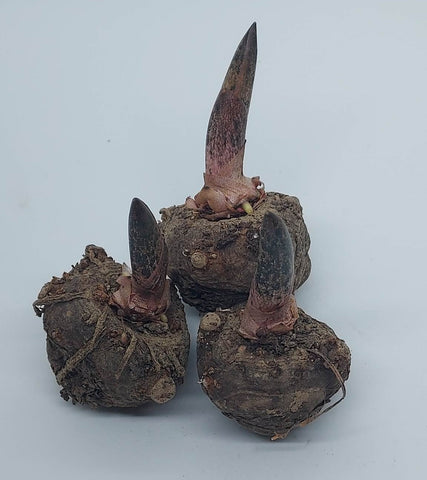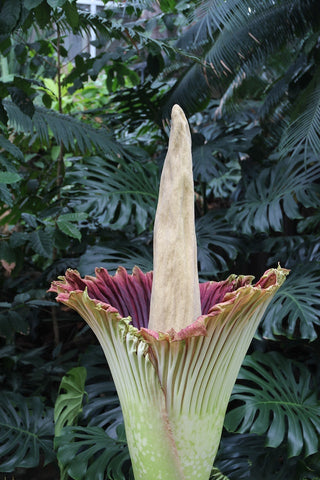Corpse Flower Care
Corpse flowers come in many different forms. Both the world's largest single flower and the world's largest inflorescence use the common name corpse flower! Though, Rafflesia arnoldii, the world's largest single flower, and Amorphophallus titanum, the world's largest inflorescence, aren't closely related at all! Most corpse flowers that are available and easily cultivated are in the Amorphophallus and Sauromatum genera which are in Araceae. This makes them closer related to a monstera than to Rafflesia arnoldii! Rafflesia arnoldii is the plant that the pokemon Vileplume is based off of. It's not easily grown in cultivation because the only portion of this plant that occurs above ground is the flower. It survives without leaves because of its parasitic nature. While Rafflesia aroldii may be one of the most fascinating plants out there, that is not what this post will be about. From this point forward, if the term "corpse flower" is used, it is referring to those in the Aroid family within the genera Amorphophallus and Sauromatum.

While it may look like a trunk with many leaves on top, that structure is actually one singular leaf! The "trunk" is a petiole (the structure that connects the leaf to the stem), and what appears to be many leaves are actually small leaflets! Other plants have similar compound leaves, like horse chestnut trees. The petiole of corpse flowers has a mottled appearance, with spots of light and dark green, giving it a unique look you cannot get with many other plants. But this leaf will eventually die back. This scares a lot of new corpse flower owners, making them think their plants have died! I have good news- they just went dormant!

Dormancy
The first thing that should be noted when you purchase a corpse flower for yourself is these plants will go dormant. There is not a way to prevent this, it will begin on its own, even if grown indoors. The leaf will die back to the soil level. When your plant is dormant, it is best to remove it from the soil and set it in a cool, dry area in your home. A basement or root cellar would work well, but garages may get too cold in winter. This also makes it easier to know when the corms are beginning to break dormancy, which is when you should return them to soil in a pot with ample room to grow. While often called bulbs, the structures that reside below the soil are not true bulbs. They are corms, a rounded underground stem that stores water and nutrients during dormancy. Other, more common plants that have these are gladioli, crocuses, and cyclamen. The photo to the left shows the corms of Amorphophallus konjac beginning to break dormancy. The leaf will begin to emerge and the roots will begin to grow again. This is when they should be returned to the soil.
Water
No plant can go without water! Similar to other aroids, corpse flowers do best when the soil is allowed to dry between waterings. Check the soil before you water to be sure the top 2-3 inches of the soil are dry before providing more water. Too much water can rot the corm, while too little can cause dormancy. When you water, be sure to completely saturate the soil. Don't give only a measured amount of water, as that can lead to overwatering. Remember, overwatering is not the amount of water you give, it's the frequency at which you give it. If your pot has holes in the bottom, water until it drains from the bottom of the pot, then add a little more. The excess will drain away if drainage holes are provided.
Sunlight
Very similar to its cousin the philodendrons, these are under story plants. Full sun can burn the single leaf this plant produces during its active growing season. Bright, indirect light, dappled sun, or shade is ideal for this plant. If you notice the leaf bending toward the light, it needs a bit more and should be supplemented with a grow light if indoors.
Soil
Corpse flowers do not typically need any special soil conditions and do well in soils fortified with fertilizers. If you find yourself to be an overwaterer, a chunky soil mix will help the soil to dry out quicker and help to prevent overwatering. Just be sure to place the corm in a pot with plenty of space for it to grow larger and for the roots to grow, as well.
Fertilizer
These plants need a lot of fertilizer in order to thrive, bloom, and grow large. If you have had roses in the past, corpse flowers require similar, if not more nutrients. Slow release granules are a great option, though may need to be supplemented with liquid or soluble fertilizers when watering. Fertilizers with a high middle number, such as many rose fertilizers, are going to perform the best for corpse flowers. The middle number on the three numbers you see on fertilizers (i.e. 18-24-16) is the percentage of phosphorous contained within the fertilizer. Phosphorous plays a major role in the division of cells and new cell growth in plants. If a corpse flower's leaf is yellowing and it is not going dormant, it likely needs fertilizer.

Blooming
Many corpse flowers are sold at a size where they will not yet bloom. Typically, when you buy a corpse flower, whether it is in its active growing stage or dormancy, they will still require a year or two before the corm is large enough to produce a flower. The size required for the plant to bloom varies from species to species. As their common name suggests, their flowers do not smell nice. They smell like carrion, or rotting meat. They do not bloom often, however, and their interesting leaves definitely make up for the smell! If possible, moving the corpse flower outside before it opens its flower would help to preserve your nose. Please also note that not every bloom will look the same as Amorphophallus titanum, as pictured to the right. All will be smaller, but have similar structure. The main difference will be the spathe, or the large, petal-like structure that wraps around the center spike, or spadix. Color and shape of the spathe will vary from species to species, as well as the smell. Some don't have as strong of odor as others. Every corpse flower species will have a showstopper bloom, nonetheless!
Adding a corpse flower to your collection is certainly going to be a conversation starter! There aren't many reasons to say no to this easy to care for plant!
As always, if you are worried about your plant for any reason, please feel free to reach out! If you send me a photo and how you've been taking care of it, I will be able to help.
Happy growing!
<3 Gina
